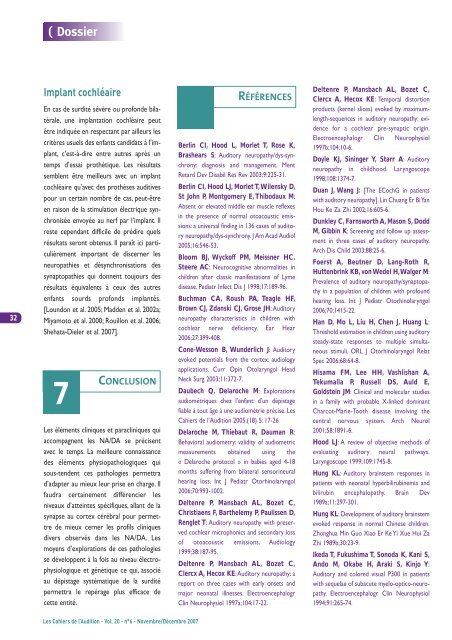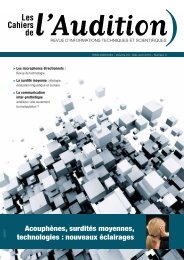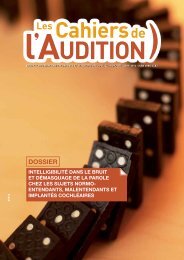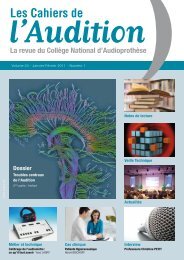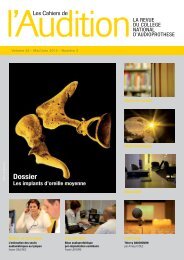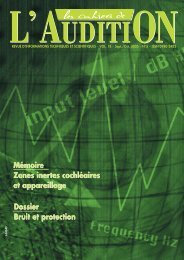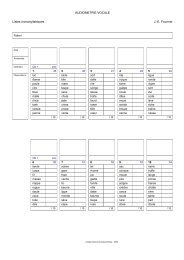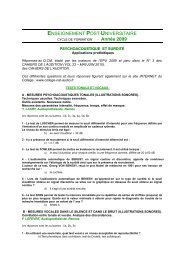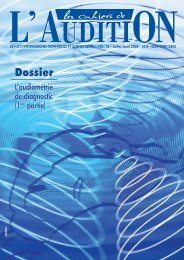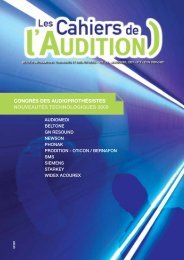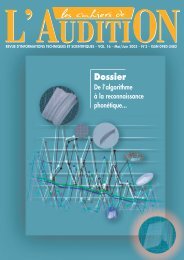la neuropathie auditive / désynchronisation auditive - Collège ...
la neuropathie auditive / désynchronisation auditive - Collège ...
la neuropathie auditive / désynchronisation auditive - Collège ...
Create successful ePaper yourself
Turn your PDF publications into a flip-book with our unique Google optimized e-Paper software.
( Dossier32Imp<strong>la</strong>nt cochléaireEn cas de surdité sévère ou profonde bi<strong>la</strong>térale,une imp<strong>la</strong>ntation cochléaire peutêtre indiquée en respectant par ailleurs lescritères usuels des enfants candidats à l’imp<strong>la</strong>nt,c’est-à-dire entre autres après untemps d’essai prothétique. Les résultatssemblent être meilleurs avec un imp<strong>la</strong>ntcochléaire qu’avec des prothèses <strong>auditive</strong>spour un certain nombre de cas, peut-êtreen raison de <strong>la</strong> stimu<strong>la</strong>tion électrique synchroniséeenvoyée au nerf par l’imp<strong>la</strong>nt. Ilreste cependant difficile de prédire quelsrésultats seront obtenus. Il paraît ici particulièrementimportant de discerner les<strong>neuropathie</strong>s et désynchronisations dessynaptopathies qui donnent toujours desrésultats équivalents à ceux des autresenfants sourds profonds imp<strong>la</strong>ntés.[Loundon et al. 2005; Madden et al. 2002a;Miyamoto et al. 2000; Rouillon et al. 2006;Shehata-Dieler et al. 2007].7CONCLUSIONLes éléments cliniques et paracliniques quiaccompagnent les NA/DA se précisentavec le temps. La meilleure connaissancedes éléments physiopathologiques quisous-tendent ces pathologies permettrad’adapter au mieux leur prise en charge. Ilfaudra certainement différencier lesniveaux d’atteintes spécifiques, al<strong>la</strong>nt de <strong>la</strong>synapse au cortex cérébral pour permettrede mieux cerner les profils cliniquesdivers observés dans les NA/DA. Lesmoyens d’explorations de ces pathologiesse développent à <strong>la</strong> fois au niveau électrophysiologiqueet génétique ce qui, associéau dépistage systématique de <strong>la</strong> surditépermettra le repérage plus efficace decette entité.RÉFÉRENCESBerlin CI, Hood L, Morlet T, Rose K,Brashears S: Auditory neuropathy/dys-synchrony:diagnosis and management. MentRetard Dev Disabil Res Rev 2003;9:225-31.Berlin CI, Hood LJ, Morlet T,Wilensky D,St John P, Montgomery E, Thibodaux M:Absent or elevated middle ear muscle reflexesin the presence of normal otoacoustic emissions:a universal finding in 136 cases of auditoryneuropathy/dys-synchrony. J Am Acad Audiol2005;16:546-53.Bloom BJ, Wyckoff PM, Meissner HC,Steere AC: Neurocognitive abnormalities inchildren after c<strong>la</strong>ssic manifestations of Lymedisease. Pediatr Infect Dis J 1998;17:189-96.Buchman CA, Roush PA, Teagle HF,Brown CJ, Zdanski CJ, Grose JH: Auditoryneuropathy characteristics in children withcochlear nerve deficiency. Ear Hear2006;27:399-408.Cone-Wesson B, Wunderlich J: Auditoryevoked potentials from the cortex: audiologyapplications. Curr Opin Oto<strong>la</strong>ryngol HeadNeck Surg 2003;11:372-7.Daubech Q, De<strong>la</strong>roche M: Explorationsaudiométriques chez l’enfant: d’un dépistagefiable à tout âge à une audiométrie précise. LesCahiers de l’Audition 2005,(18) 5: 17-26De<strong>la</strong>roche M, Thiebaut R, Dauman R:Behavioral audiometry: validity of audiometricmeasurements obtained using the« De<strong>la</strong>roche protocol » in babies aged 4-18months suffering from bi<strong>la</strong>teral sensorineuralhearing loss. Int J Pediatr Otorhino<strong>la</strong>ryngol2006;70:993-1002.Deltenre P, Mansbach AL, Bozet C,Christiaens F, Barthelemy P, Paulissen D,Renglet T: Auditory neuropathy with preservedcochlear microphonics and secondary lossof otoacoustic emissions. Audiology1999;38:187-95.Deltenre P, Mansbach AL, Bozet C,Clercx A, Hecox KE: Auditory neuropathy: areport on three cases with early onsets andmajor neonatal illnesses. ElectroencephalogrClin Neurophysiol 1997a;104:17-22.Deltenre P, Mansbach AL, Bozet C,Clercx A, Hecox KE: Temporal distortionproducts (kernel slices) evoked by maximumlength-sequencesin auditory neuropathy: evidencefor a cochlear pre-synaptic origin.Electroencephalogr Clin Neurophysiol1997b;104:10-6.Doyle KJ, Sininger Y, Starr A: Auditoryneuropathy in childhood. Laryngoscope1998;108:1374-7.Duan J, Wang J: [The ECochG in patientswith auditory neuropathy]. Lin Chuang Er Bi YanHou Ke Za Zhi 2002;16:605-6.Dunkley C, Farnsworth A, Mason S, DoddM, Gibbin K: Screening and follow up assessmentin three cases of auditory neuropathy.Arch Dis Child 2003;88:25-6.Foerst A, Beutner D, Lang-Roth R,Huttenbrink KB, von Wedel H,Walger M:Prevalence of auditory neuropathy/synaptopathyin a popu<strong>la</strong>tion of children with profoundhearing loss. Int J Pediatr Otorhino<strong>la</strong>ryngol2006;70:1415-22.Han D, Mo L, Liu H, Chen J, Huang L:Threshold estimation in children using auditorysteady-state responses to multiple simultaneousstimuli. ORL J Otorhino<strong>la</strong>ryngol Re<strong>la</strong>tSpec 2006;68:64-8.Hisama FM, Lee HH, Vashlishan A,Tekumal<strong>la</strong> P, Russell DS, Auld E,Goldstein JM: Clinical and molecu<strong>la</strong>r studiesin a family with probable X-linked dominantCharcot-Marie-Tooth disease involving thecentral nervous system. Arch Neurol2001;58:1891-6.Hood LJ: A review of objective methods ofevaluating auditory neural pathways.Laryngoscope 1999;109:1745-8.Hung KL: Auditory brainstem responses inpatients with neonatal hyperbilirubinemia andbilirubin encephalopathy. Brain Dev1989a;11:297-301.Hung KL: Development of auditory brainstemevoked response in normal Chinese children.Zhonghua Min Guo Xiao Er Ke Yi Xue Hui ZaZhi 1989b;30:23-9.Ikeda T, Fukushima T, Sonoda K, Kani S,Ando M, Okabe H, Araki S, Kinjo Y:Auditory and colored visual P300 in patientswith seque<strong>la</strong>e of subacute myelo-optico-neuropathy.Electroencephalogr Clin Neurophysiol1994;91:265-74.Les Cahiers de l’Audition - Vol. 20 - n°6 - Novembre/Décembre 2007


